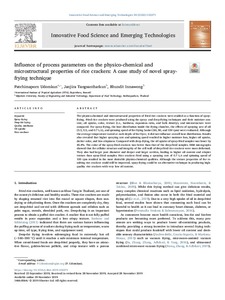| dc.contributor.author | Udomkun, P. |
| dc.contributor.author | Tangsantaskul, J. |
| dc.contributor.author | Innawong, B. |
| dc.date.accessioned | 2020-01-06T09:24:56Z |
| dc.date.available | 2020-01-06T09:24:56Z |
| dc.date.issued | 2020 |
| dc.identifier.citation | Udomkun, P., Tangsantaskul, J. & Innawong, B. (2019). Influence of process parameters on the physico-chemical and microstructural properties of rice crackers: a case study of novel spray-frying technique. Innovative Food Science & Emerging Technologies, 59, 1-7. |
| dc.identifier.issn | 1466-8564 |
| dc.identifier.uri | https://hdl.handle.net/20.500.12478/6556 |
| dc.description.abstract | The physico-chemical and microstructural properties of fried rice crackers were studied as a function of spray-frying. Fried rice crackers were produced using the spray- and deep-frying techniques and their moisture content, oil uptake, color, texture (i.e., hardness, expansion ratio, and bulk density), and microstructure were compared. For spray-frying, the heat distribution inside the frying chamber, the effects of spraying rate of oil (0.3, 0.5, and 0.7 L/s), and spinning speed of the frying basket (60, 80, and 100 rpm) were evaluated. Although the average temperature varied at each depth of the fryer, it did not influence overall heat distribution. Results also revealed that higher spraying rate and spinning speed resulted in higher moisture loss, higher oil uptake, darker color, and less crispiness. Compared with deep-frying, the oil uptake of spray-fried samples was lower by 45.4%. The color of the spray-fried crackers was better than that of the deep-fried samples. SEM micrographs showed that the cellular structure and integrity of the cell wall of deep-fried rice crackers were more deformed. They also had larger pore diameter and deeper and larger cavities, leading to higher oil content and crispier texture than spray-fried samples. Rice crackers fried using a spraying rate of 0.7 L/s and spinning speed of 100 rpm resulted in the most desirable physico-chemical qualities. Although the texture properties of the resulting rice crackers could still be improved, spray-frying could be an alternative technique in producing high-quality rice crackers with very low oil content. |
| dc.language.iso | en |
| dc.subject | quality |
| dc.subject | Rice |
| dc.subject | Sprays |
| dc.subject | Food safety |
| dc.subject | Quality |
| dc.subject | Food Security |
| dc.subject | Chemicophysical Properties |
| dc.title | Influence of process parameters on the physico-chemical and microstructural properties of rice crackers: a case study of novel sprayfrying technique |
| dc.type | Journal Article |
| cg.contributor.crp | Agriculture for Nutrition and Health |
| cg.contributor.affiliation | International Institute of Tropical Agriculture |
| cg.contributor.affiliation | Silpakorn University |
| cg.coverage.hub | Central Africa Hub |
| cg.creator.identifier | Patchimaporn Udomkun: 0000-0003-0115-1997 |
| cg.researchtheme | Natural Resource Management |
| cg.isijournal | ISI Journal |
| cg.authorship.types | CGIAR and developing country institute |
| cg.iitasubject | Food Science |
| cg.iitasubject | Food Security |
| cg.iitasubject | Food Systems |
| cg.iitasubject | Nutrition |
| cg.journal | Innovative Food Science and Emerging Technologies |
| cg.notes | Published online: 29 Nov 2019 |
| cg.accessibilitystatus | Limited Access |
| cg.reviewstatus | Peer Review |
| cg.usagerightslicense | Copyrighted; all rights reserved |
| cg.targetaudience | Scientists |
| cg.identifier.doi | https://dx.doi.org/10.1016/j.ifset.2019.102271 |

